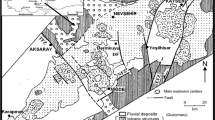Abstract
In engineering applications of rock materials, predicting the uniaxial compressive strength (UCS) is essential, particularly in the preliminary stage of a project. The UCS of rock materials is profoundly affected by the rock type, porosity, grain size, water content, etc. The rigor and cost of sampling as well as sample preparation are more than those of the Brazilian (indirect tensile strength, ITS) and 2nd cycle of slake durability index (Id2) tests. Therefore, ITS or Id2 values can be used to predict the UCS value of rocks through correlation. In this study, evaporitic rocks from Al Ain, United Arab Emirates (UAE) were examined. Forty-eight representative rock blocks were collected, while avoiding anisotropy effects of thinly bedded rocks along with the gypsiferous layers. The relations between UCS and ITS and UCS and Id2 were estimated with representative empirical equations. Results reveal moderate correlation between them. Moreover, Student’s t and F tests show that there is a significant correlation between UCS and ITS and Id2. Further, the fit between the predicted and measured values was evaluated in terms of the 1:1 line, a good index to confirm the reliability of the empirical relationship. Finally, the study demonstrates that ITS or Id2 can estimate the UCS of evaporitic rocks within a certain correlation coefficient, R.

(modified from Geological Map, 2006)





Similar content being viewed by others
Availability of Data and Material
The datasets generated and/or analysed during the current study are available from the corresponding author on reasonable request.
Code Availability
No specific software was used for this study.
References
Arman H, Abdelghany O, Abu Saima M, Aldahan A, Mabmoud B, Hussein S, Fowler A, AlRashidi S (2019) Strength estimation of evaporitic rocks using different testing methods. Arab J Geosci 12(721):1–9. https://doi.org/10.1007/s12517-019-4916-9
Arslan AT, Koca MY, Aydogmus T, Klapperich H, Yilmaz HR (2008) Correlation of unconfined compressive strength with young’s modulus and poisson’s ratio in gypsum from Sivas (Turkey). Rock Mech Rock Eng Tech Note 41:941–950. https://doi.org/10.1007/s00603-007-0145-8
ASTM D2938–95 (1995) Standard test method for unconfined compressive strength of intact rock core specimens. ASTM International, West Conshohocken, PA
ASTM D4543–08e1 (2008) Standard Practices for Preparing Rock Core as Cylindrical Test Specimens and Verifying Conformance to Dimensional and Shape Tolerances (Withdrawn 2017) ASTM International. West Conshohocken, PA, USA
ASTM D 3967–08 (2008) Standard test method for splitting tensile strength of intact rock core specimens. ASTM International, West Conshohocken, PA, USA
ASTM D4644–16 (2016) Standard Test Method for Slake Durability of Shales and Other Similar Weak Rocks. ASTM International, West Conshohocken, PA
Brisevac Z, Kujundzic T, Macenic M (2017) Estimation of uniaxial compressive and tensile strength of rock material from gypsum deposits in the Knin area. Tehnicki Vjesnik 24(3):855–861
Deer WA, Howie RA, Zussman J (1962) Rock forming minerals non-silicates. Longmans, London
Heidari M, Khanlari GH, Kaveh MT, Kargarian S (2012) Predicting the uniaxial compressive and tensile strength of gypsum rock by point load testing. Rock Mech Rock Eng Tech Note 45:265–273. https://doi.org/10.1007/s00603-011-0196-8
International Society of Rock Mechanics (1981) In: Brown ET (ed) ISRM suggested methods: rock characterization testing and monitoring. Pergamon Press, Oxford
Karacan E, Yilmaz I (2000) Geotechnical evaluation of miocene gypsum from Sivas (Turkey). Geotech Geol Eng 18:79–90. https://doi.org/10.1023/A:1008969726200
Kurtulus C, Sertcelik F, Sertcelik I (2018) Estimation of unconfined compressive strength using schmidt hardness and ultrasonic pulse velocity. Tehnicki Vjesnik 25(5):1569–1574. https://doi.org/10.17559/TV-20170217110722
Yilmaz I (2007) Differences in the geotechnical properties of two types of gypsum: alabastrine and porphyritic. B Eng Geol Environ 66:187–195. https://doi.org/10.1007/s10064-006-0055-0
Yilmaz I, Sendir H (2002) Correlation of schmidt hardness with unconfined compressive strength and young’s modulus in gypsum from Sivas (Turkey). Eng Geol 66:211–219. https://doi.org/10.1016/s0013-7952(02)00041-8
Acknowledgments
The author would like to express sincere appreciation to Prof. Ala Aldahan, Dr. Osman Abdelghany, Dr. Mahmoud Abu Saima, and Dr. Bahaa Al-deen for their valuable insights, interpretations, and comments on mineralogical and textural studies on rock samples. Special thanks to research assistants, technicians, graduates, and undergraduate students of my University in the field and in the laboratory.
Funding
The United Arab Emirates University, Research Affairs, financially supported this research under the title of UPAR 2016–31S252 program.
Author information
Authors and Affiliations
Contributions
This is a single author paper. Moreover, the author already listed appreciated names for their valuable insights, interpretations, comments, etc. for this manuscript.
Corresponding author
Ethics declarations
Conflict of interest
The author declares no conflict of interest.
Additional information
Publisher's Note
Springer Nature remains neutral with regard to jurisdictional claims in published maps and institutional affiliations.
Rights and permissions
About this article
Cite this article
Arman, H. Correlation of Uniaxial Compressive Strength with Indirect Tensile Strength (Brazilian) and 2nd Cycle of Slake Durability Index for Evaporitic Rocks. Geotech Geol Eng 39, 1583–1590 (2021). https://doi.org/10.1007/s10706-020-01578-x
Received:
Accepted:
Published:
Issue Date:
DOI: https://doi.org/10.1007/s10706-020-01578-x




